This post may contain affiliate links. By clicking and making a purchase through the links, I earn a small commission at no extra cost to you. See my disclaimer for more information. This and display ads allow me to keep the site up to date and give back.
Mount Fuji has long been top of the list for travelers planning their Shizuoka itinerary, including myself. Its majestic presence offers more than just a picturesque backdrop; it’s a spiritual experience deeply ingrained in Japanese culture.
But like many overtouristed destinations, Mount Fuji is facing problems with local governments fearing the mountain could lose its status as a UNESCO World Heritage Site.
The influx of tourists has led to stress on the local communities and environmental concerns, which threaten the very essence of Mount Fuji’s natural beauty and its ecological balance.
Today, visiting Mount Fuji sustainably is about more than enjoying its beauty; it’s about showing respect and care for a place that holds immense cultural and spiritual significance.
This journey through Shizuoka, leading to the majestic Mount Fuji, is more than just an itinerary; it’s an exploration of sustainability, culture, and the unspoken stories of Japan’s heartland.
From the lush wasabi fields to the tranquil coastlines, each step in this region is a step towards understanding the delicate balance between tourism and preservation.
This itinerary highlights the beauty of exploring responsibly, connecting with local communities, and embracing the path less traveled.
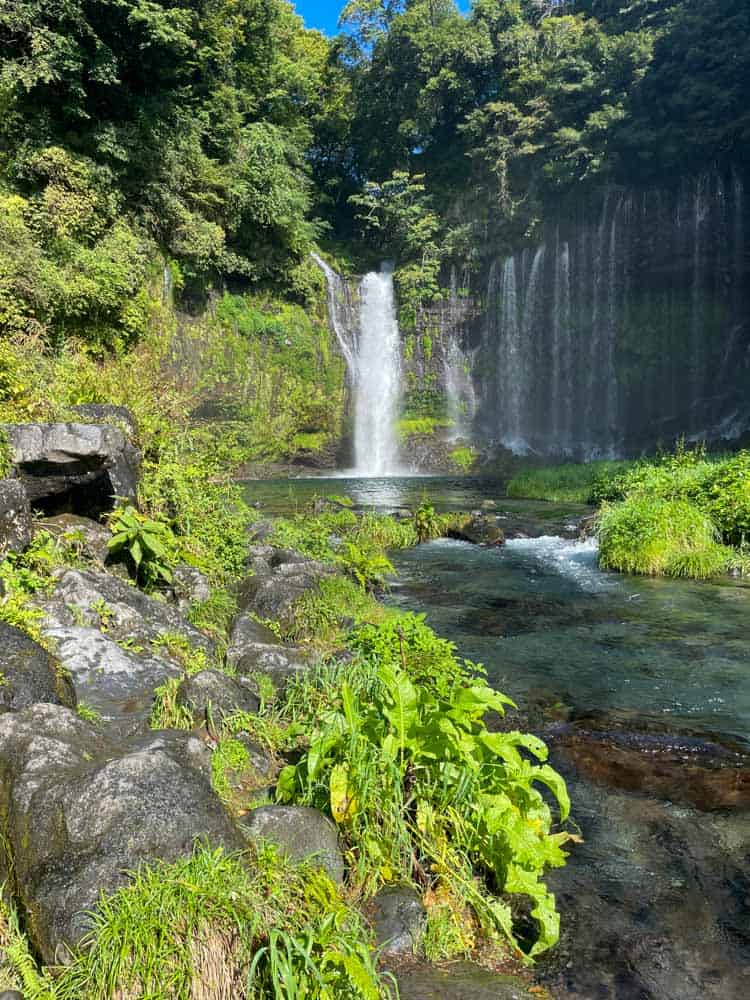
My visit to Shizuoka was kindly hosted as a media delegate at the Adventure World Summit in Japan. Thank you to Explore Shizuoka, the Adventure Travel Trade Association, and Kodo Travel for putting together this incredible trip. As always, all opinions are my own.
One Week Shizuoka Itinerary
Day 1: Mishima to Shuzenji
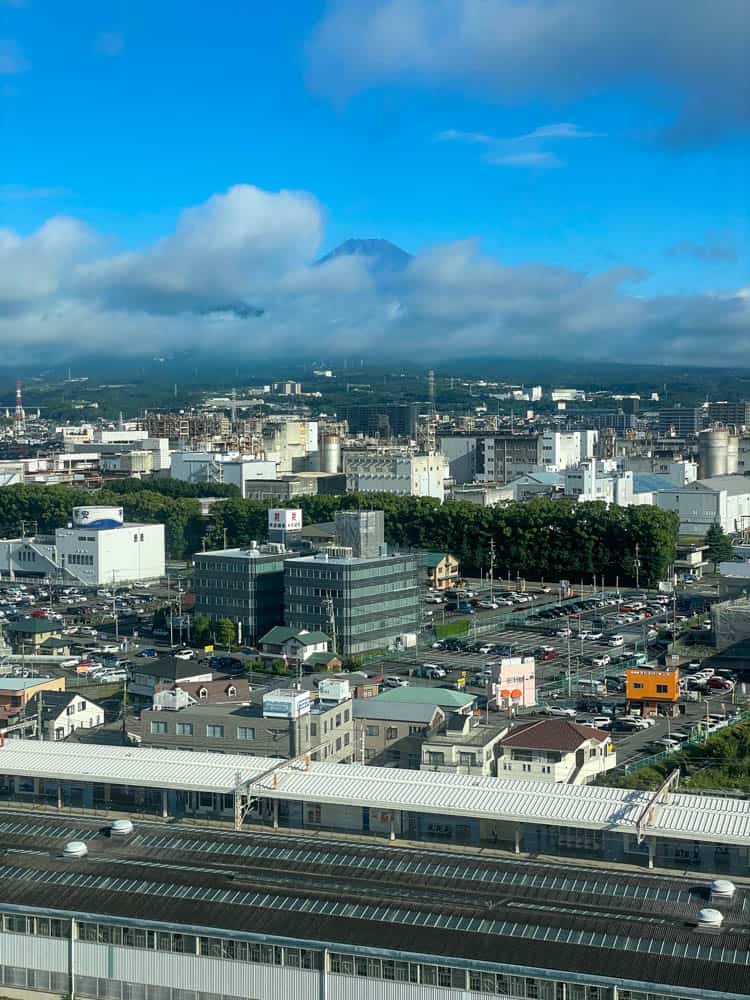
We began our Shizuoka itinerary in the city of Mishima, just an hour from Tokyo and easily accessible by train from the airport. Mishima is the perfect gateway to the wonders of Mount Fuji and the Izu Peninsula.
The Izu peninsula was originally a group of volcanic islands in the South Seas, colliding with the main island of Japan about 600,000 years ago, resulting in the peninsula.
Volcanic activity and crustal movements continue to this day, which results in abundant hot springs. It’s a paradise for adventure travel!
Upon arriving in Mishima, I checked into the Fujisan Mishima Tokyu Hotel and went straight to the hotel’s rooftop onsen, where I got my first view of Mount Fuji.
Relaxing in an onsen was the perfect way to beat my jet lag coming off a 12-hour flight, and the serene setting meant the tone for what was to be an extraordinary trip.
Day 2: Mishima to Shuzenji

The following day, we met our guides and embarked on a walk through the town. The Shimoda Kaido, an ancient path that starts here, traces the length of the Izu Peninsula.
It was my first walk through Japan’s forests, which I quickly fell in love with. The crystal clear spring water from Mount Fuji’s snowmelt guides the tranquil paths.
During the walk, I learned that 75% of Japan is covered in forest, and almost all of it was planted. That’s pretty impressive to think about – if only the rest of the world would follow suit.
After our walk, we headed to Shuzenji via a quick train ride. Japan’s train system is truly impressive and makes getting around a breeze.
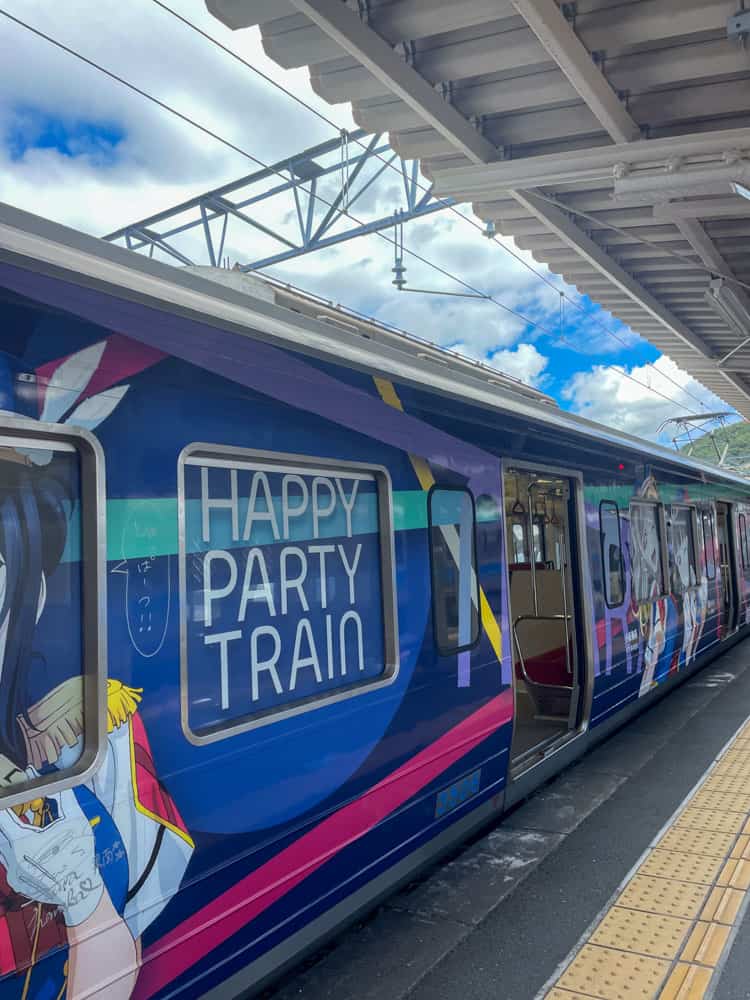
We had a quick lunch before picking up electric bikes for the next leg of our journey. There are bike routes all along the Izu Peninsula, and e-bikes can be easily rented.

Our bike ride took us alongside the Kano River, through Izu-no-kuni, where the roots of Samurai culture date back to the 12th century. We delved into the history of Masako Hojo, one of the most powerful female Shoguns, while cycling through ancient homes.
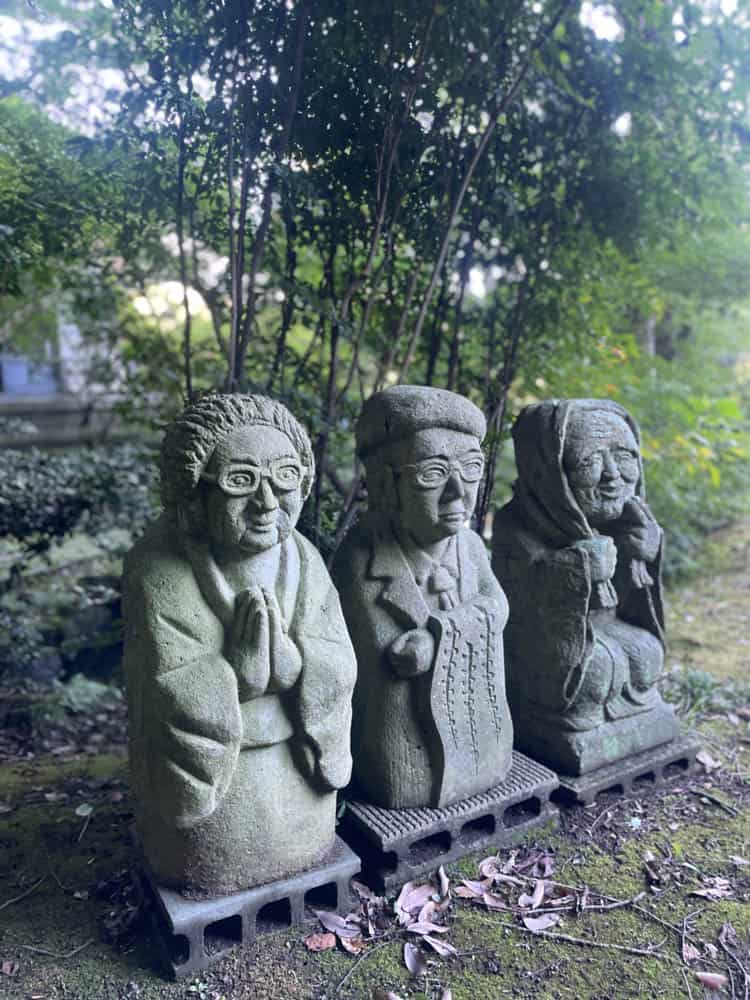
The 10 km ride on e-bikes, mostly on flat, sealed roads, was incredibly scenic. Aside from the heat, it was a fantastic way to start our trip in Japan and made me want to incorporate biking more into my travels.
By late afternoon, we arrived in Shuzenji, a hot spring town with a history dating back to 807 AD.
Our stay at Arai Ryokan was like stepping back in time. This heritage building, dating back to 1872, is a traditional Japanese Inn set amidst stunning gardens and carp-filled ponds.

The tatami floors, rice-paper screens, and futons in our rooms, along with decor by renowned Japanese painters, offered an authentic experience of old Japan.
I was a bit confused when I first entered my room, as there was no bed when you came in. After looking around in every nook and cranny, I realized that they bring the futon later in the evening, replacing the table in the middle of the room.

While it may seem basic, it’s comfortable and truly an experience you must have in Japan. My room also had its own private onsen tub and the most beautiful views of the forest outside.
The evening was a cultural immersion with Geisha entertainment during our multi-course Kaiseki meal. Kumi-san, an English-speaking Geisha, provided a rare insight into this fascinating culture.
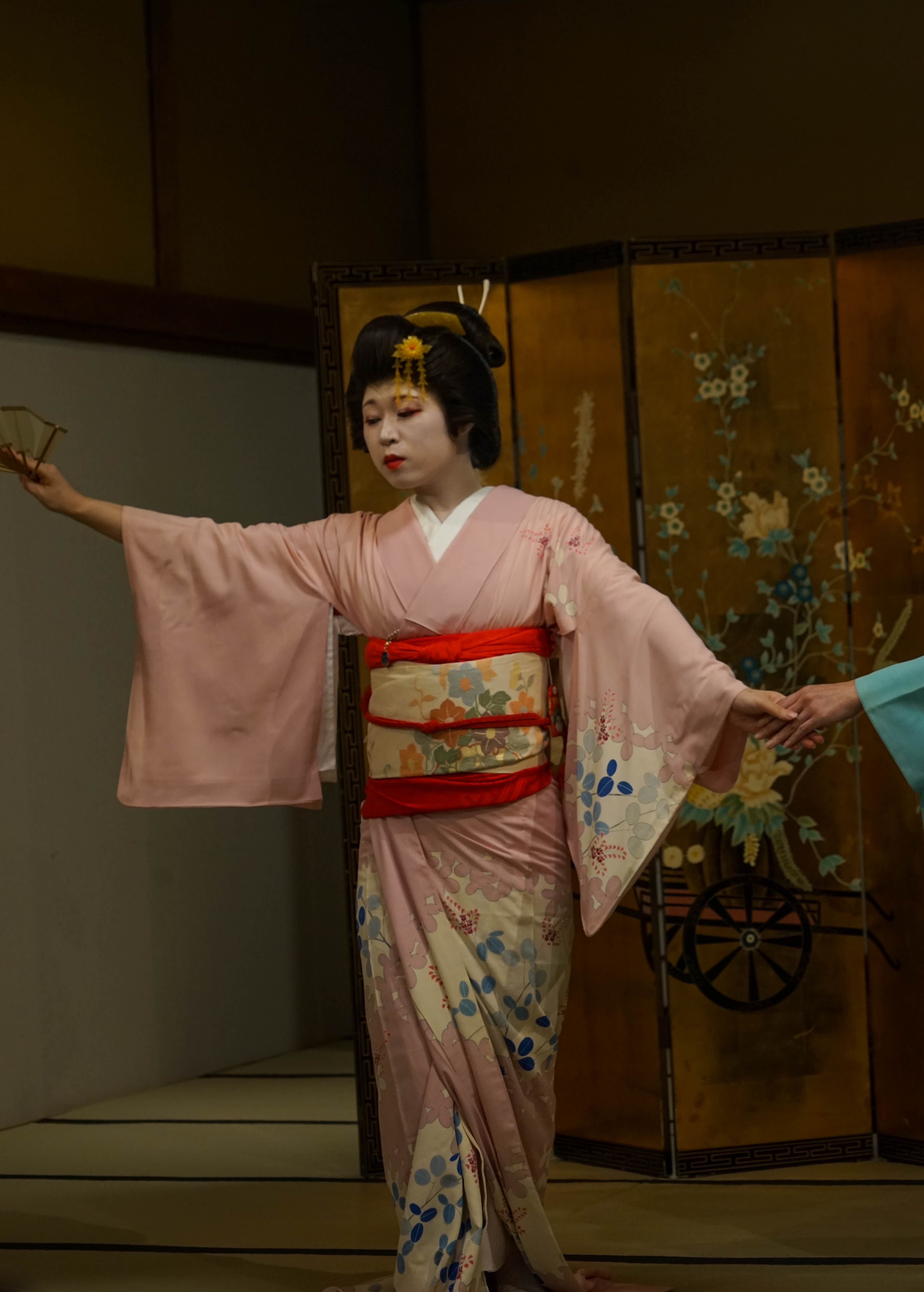
I expected to be watching the Geisha’s perform for most of the night, but they quickly involved us in the fun. The evening was filled with games, laughter, and exquisite food, allowing us to try many new dishes.
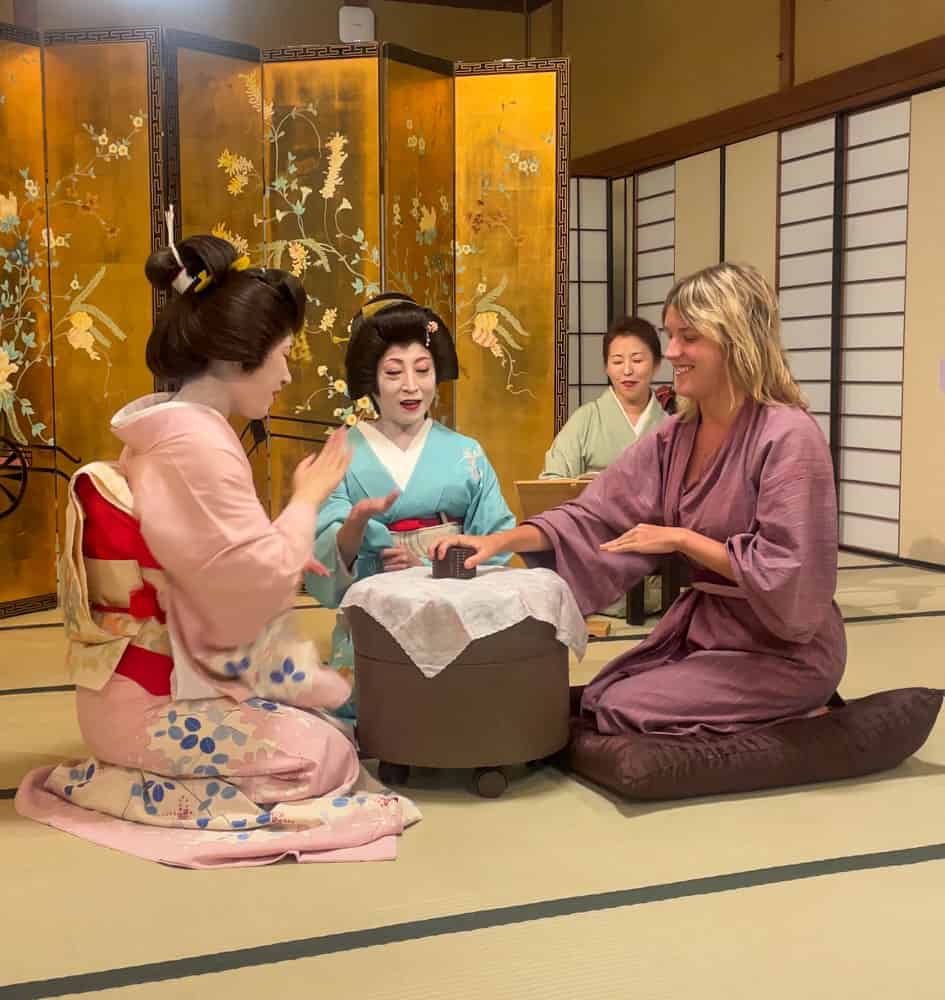
At the end of the day, I soaked in the outdoor onsen, reflecting on what was truly a perfect travel day, filled with culture, history, and the serene beauty of Japan.
Day 3: Shuzenji to Matsuzaki
The second day of our Shizuoka adventure started with a traditional Japanese breakfast at Arai Ryokan, which is always an adventurous way to start the day.
We checked out of the inn for a 30-minute drive to Mt. Amagi, the highest peak on the Izu Peninsula.
Our plan for the day was to walk a descending trail along a beautiful section of the old Shimoda Kaido. This historic inland route was primarily used for salt trade during the Edo period.
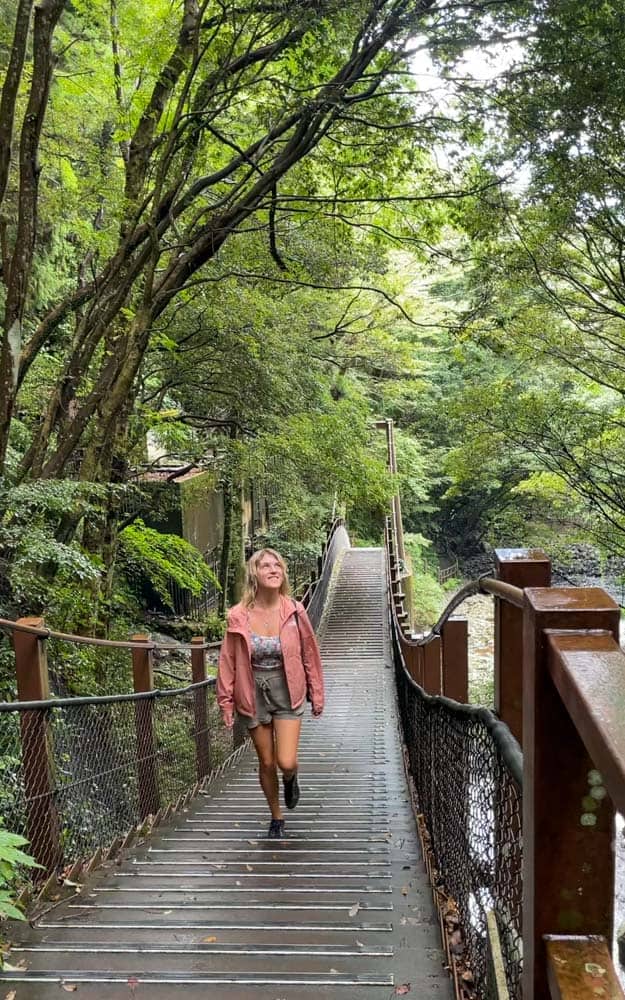
The highlight of the trail was undoubtedly the Kawazu Seven Waterfalls (Nanadaru), a series of 7 waterfalls from 2 to 30 m. tall, along a 1 km lush forest walking trail. These falls are a significant reason why Izu boasts its Geopark status.
The sound of the water, combined with the lush greenery and blue waterfalls, created a beautiful and peaceful ambiance. However, if you want a more exhilarating experience, we saw people canyoning over the falls!
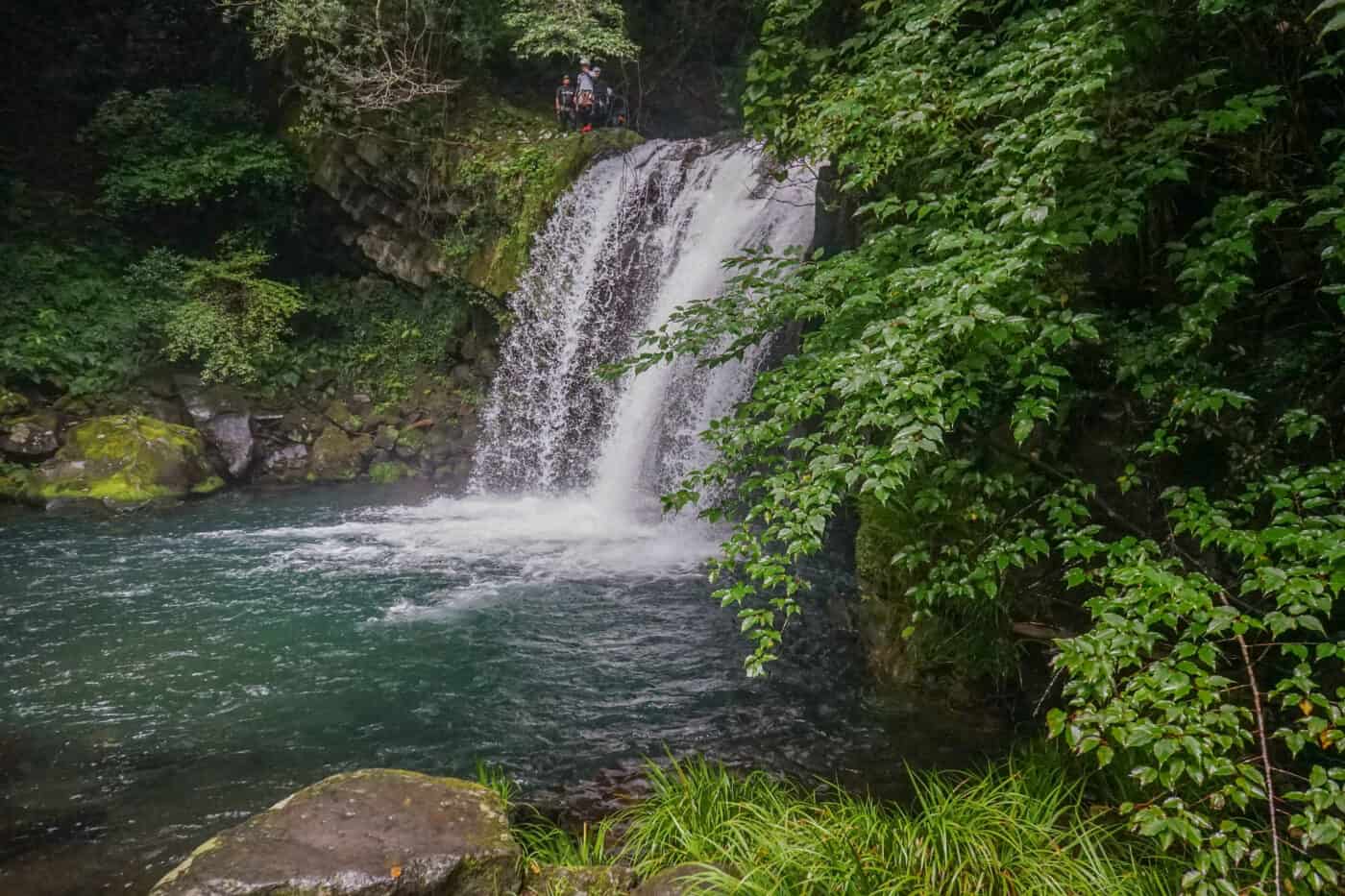
After a quick but tasty lunch at 85 Cafe in Shimoda, we continued our e-bike tour along the stunning south coast, which stretches from Shimoda to the southernmost tip of the Izu Peninsula, Irozaki Cape.
Shimoda holds a special place in Japanese history as one of the early trading ports that opened following the arrival of US Commodore Matthew Perry and his ‘Black Ships.’ This era marked a dramatic shift in Japan’s history, and the stories from that time are as fascinating.
As we pedaled along the coastal road, we passed by picturesque coves.
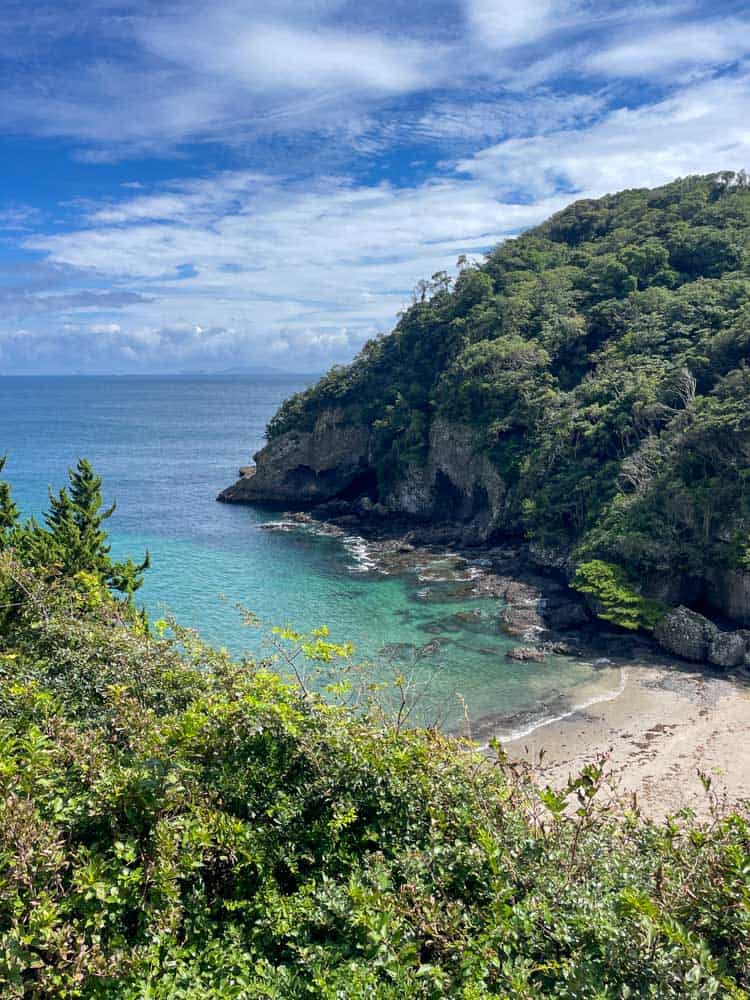
I was very grateful for the choice of e-bikes for this terrain, making the inclines manageable and the ride much more enjoyable.
As we got closer to the southernmost point of the peninsula, we found ourselves racing against an approaching storm. The weather, unpredictable as it is, is all part of the adventure when traveling.
We managed to catch a glimpse of the cape’s stunning views before deciding to take the van back, narrowly escaping the downpour.
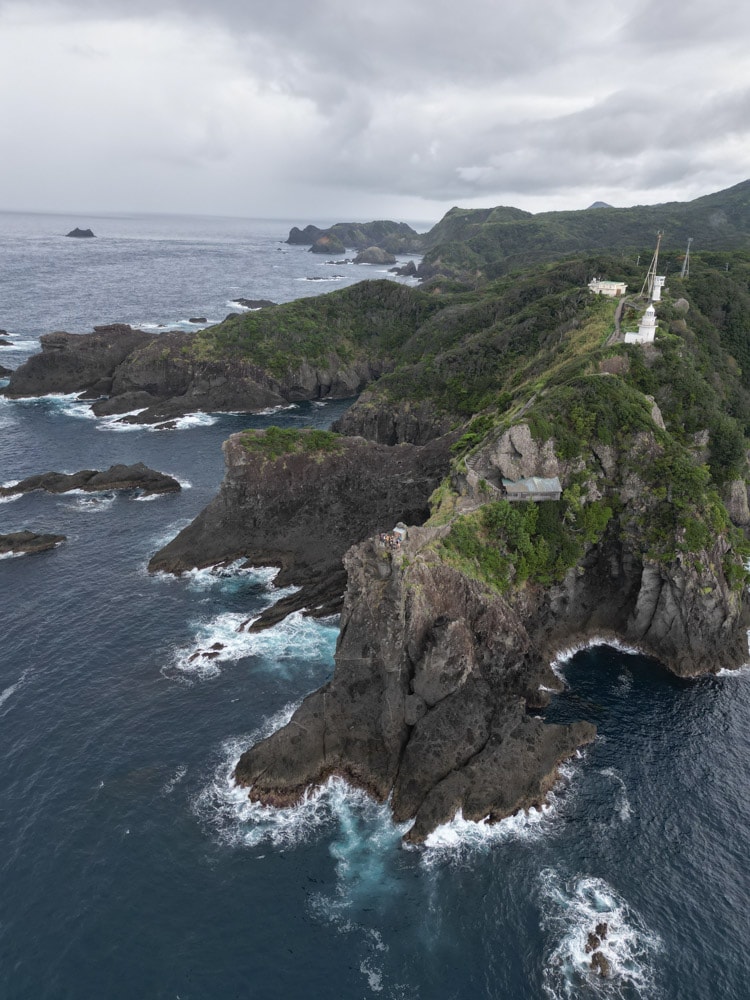
This turn of events, while cutting our e-bike adventure short, was a reminder of the excitement and unpredictability of adventure travel. It’s about embracing the moment, adapting to changes, and enjoying the journey, rain or shine.
Matzuzaki is a small seaside town in Japan that reminded me of the small towns of Newfoundland. We checked into the Toyosaki Hotel, a cozy establishment that we had all to ourselves for the night.
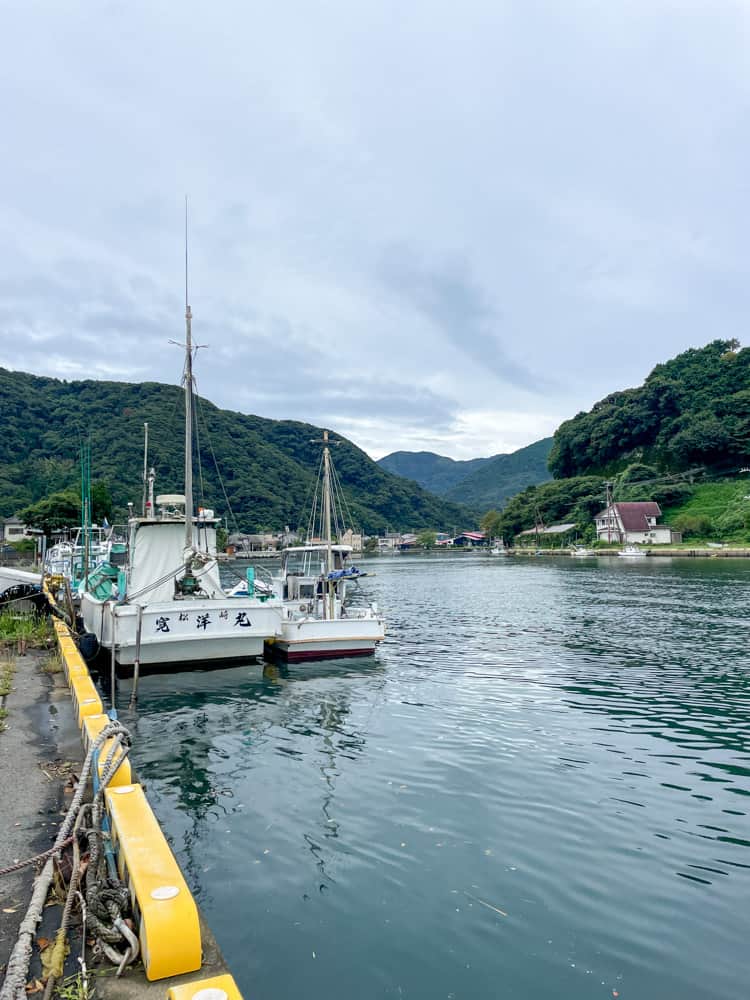
The rooms, adorned with tatami floors and comfortable futons, offered another authentic Japanese living experience.
The highlight of the hotel was undoubtedly the onsen tubs on the balcony. Overlooking the ocean, these hot spring baths provided a tranquil space to unwind and reflect on the day’s experiences.
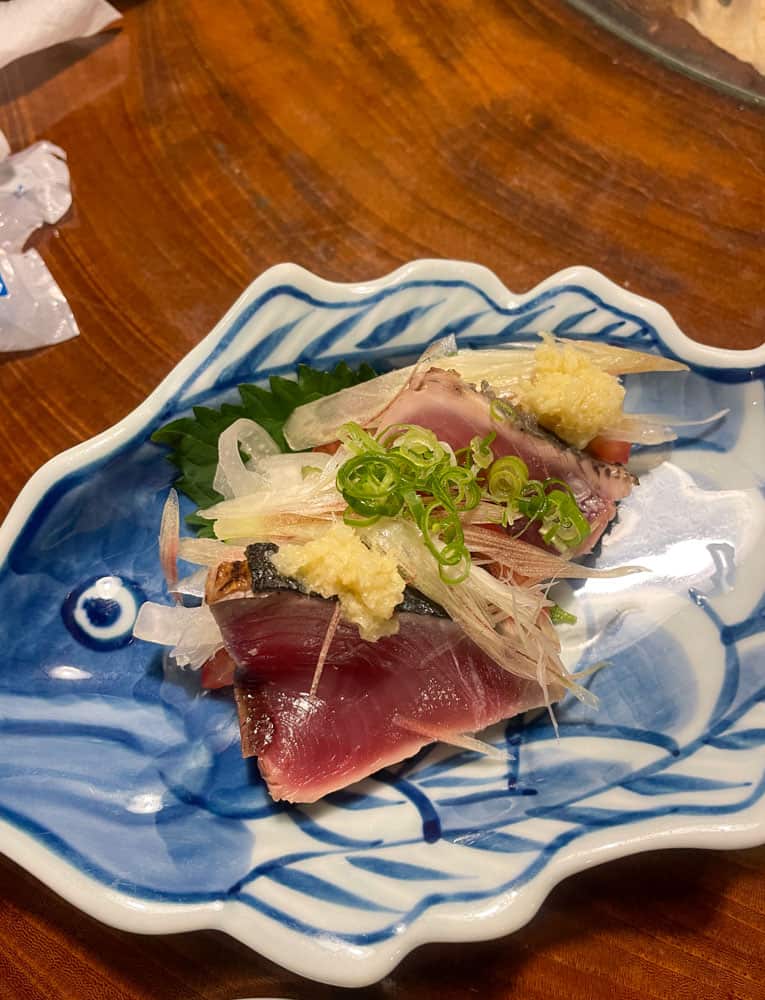
Our evening finished with a dinner at Mingei Sabou, known for its exquisite local seafood. Each dish showcased the freshness and flavor of the local catch, all served in warm Japanese hospitality.
Day 4: Matzuzaki to Fujisan
The following day in West Izu brought with it new adventures. While some opted for an adrenaline-pumping mountain biking experience, others, including myself, chose a more serene activity – kayaking in the ocean.
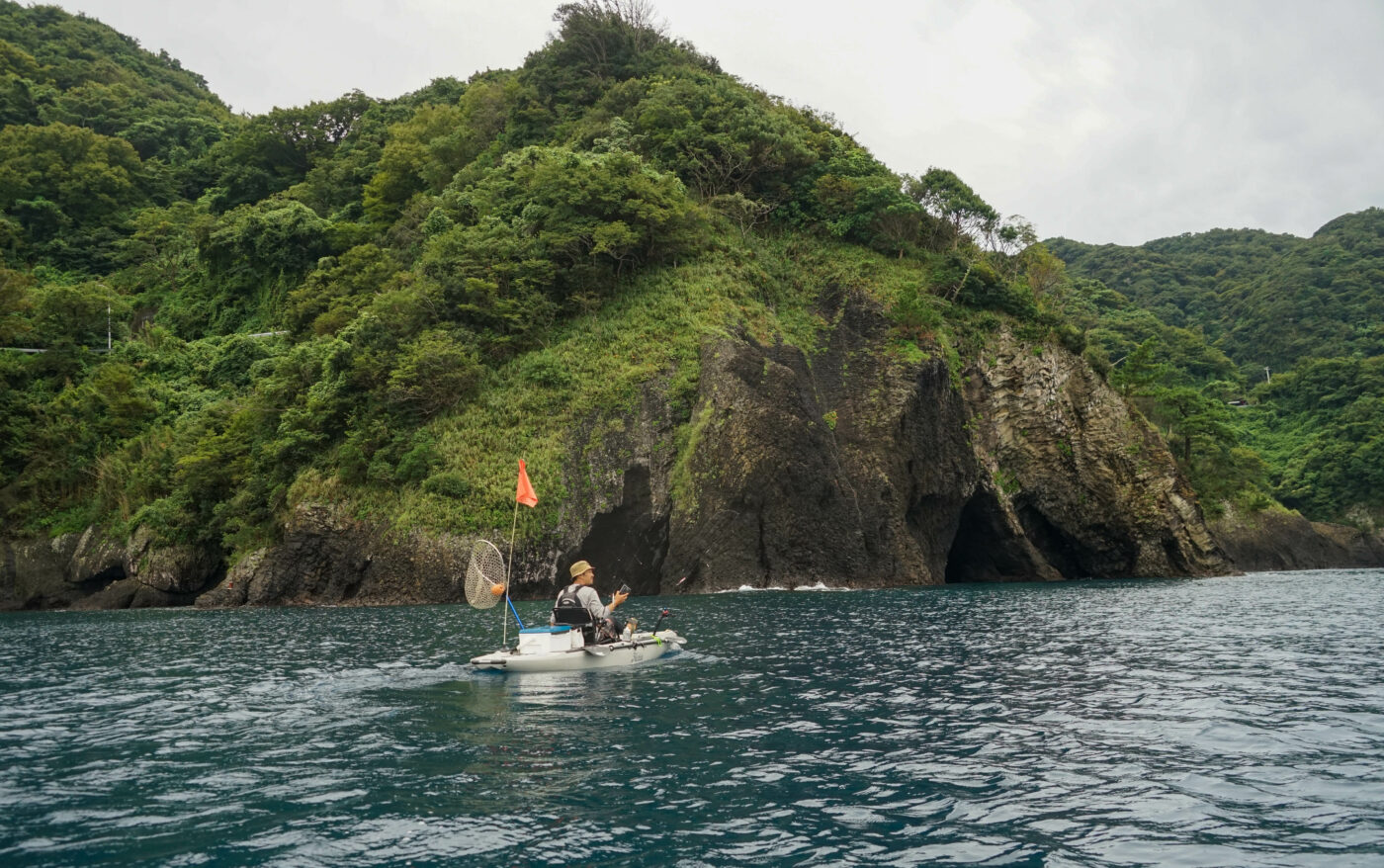
The kayaking experience was unique, thanks to the pedal-powered kayaks. These innovative kayaks made the journey effortless and enjoyable, especially for those of us who were new to this activity. The calm waters near the coast of West Izu were perfect for a peaceful morning on the sea.
The beauty of kayaking here is the proximity to the deep sea trench of Suruga Bay. The sea floor drops steeply, but you don’t need to venture far from the coast to experience the vastness of the ocean.
Some of my companions chose to fish, but for me, it was all about soaking in the peaceful atmosphere, the gentle movement of the water, and the occasional glimpses of Mount Fuji in the distance.
Our adventure continued as we departed Matsuzaki, embarking on a scenic 2-hour drive towards Fujinomiya, nestled in the foothills of Mount Fuji.
Fujii Wasabi-en
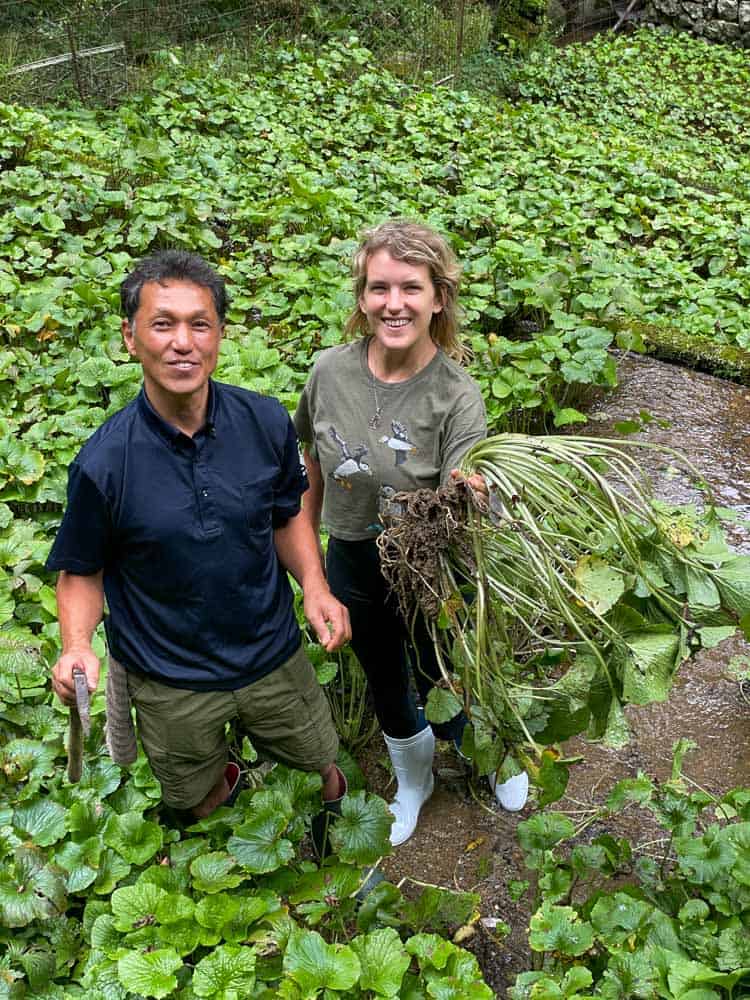
Our destination before reaching Fujinomiya was Fujii Wasabi-en, a renowned wasabi farm in Shizuoka. Shizuoka is celebrated for its wasabi, a plant integral to Japan’s sushi and sashimi culture.
The wasabi farm visit wasn’t just a lunch stop; it was a highlight of the trip. We had the opportunity to meet a couple who left their corporate city life to revive a forgotten wasabi farm. Their dedication has turned this farm into one of the few that produces 100% organic wasabi.
The farm, with its clear water feeding the wasabi fields, was so beautiful to walk through.
We got to take part in the entire process of harvesting the wasabi from the ground to our plate, which was such a fun experience. The process of harvesting the wasabi ourselves was both enlightening and enjoyable, and we even got a piece of wasabi each to take back home.
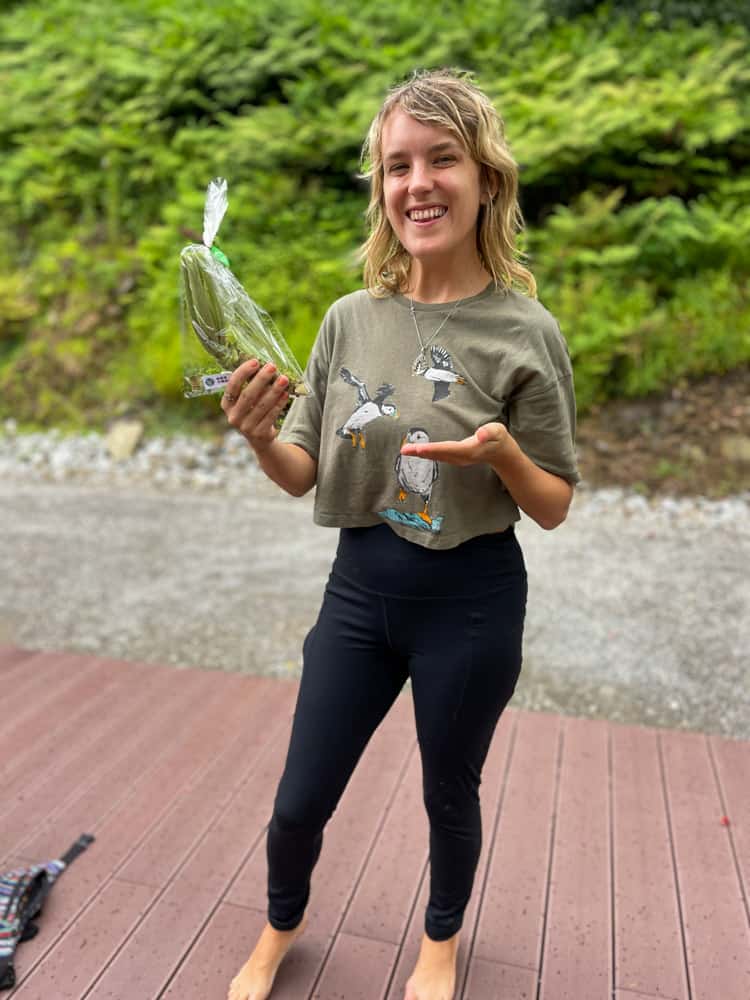
Afterward, we had a memorable lunch on their beautiful beautiful using the fresh wasabi. As someone who usually doesn’t like wasabi, I was pleasantly surprised by the freshness and flavor of the wasabi we prepared.
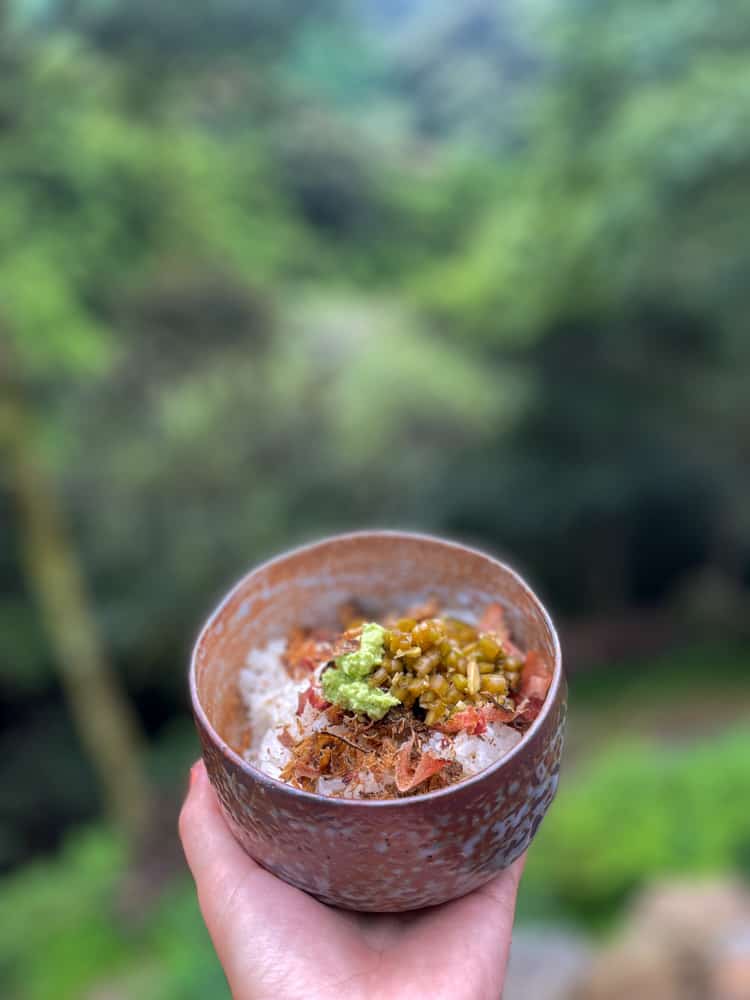
The lunch was served family-style, allowing us to get to know the family more, who were so lovely. I was so inspired by their story to leave the fast-paced life of Tokyo to start the wasabi farm – reminding me of my own journey to pursue my love of travel.
From there, we drove to our glamping accommodations for the night, owned by Mount Fuji Eco Tours.
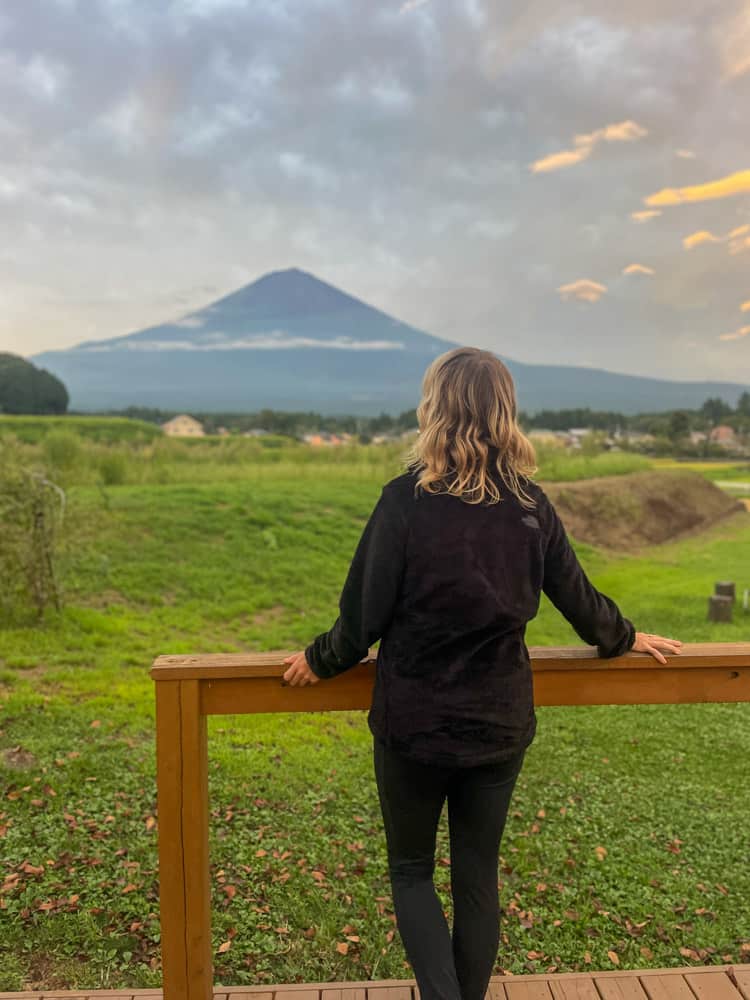
The owner, Masa, isn’t just running a glamping site; he’s a specialist in Eco Tourism with a wealth of experience.
His expertise and passion for sustainable tourism are evident in every aspect of the accommodations, creating not only a comfortable stay but one that is environmentally conscious.
Unfortunately, there were high winds in the forecast, precursors to an impending typhoon, which meant that staying in the tents wasn’t safe. Masa, ever the attentive and resourceful host, quickly arranged for alternate accommodations inside.
However, when we arrived, the weather was still calm, so we all sat on the porch watching a stunning sunset over Mount Fuji, which was one of my favorite moments from the trip.
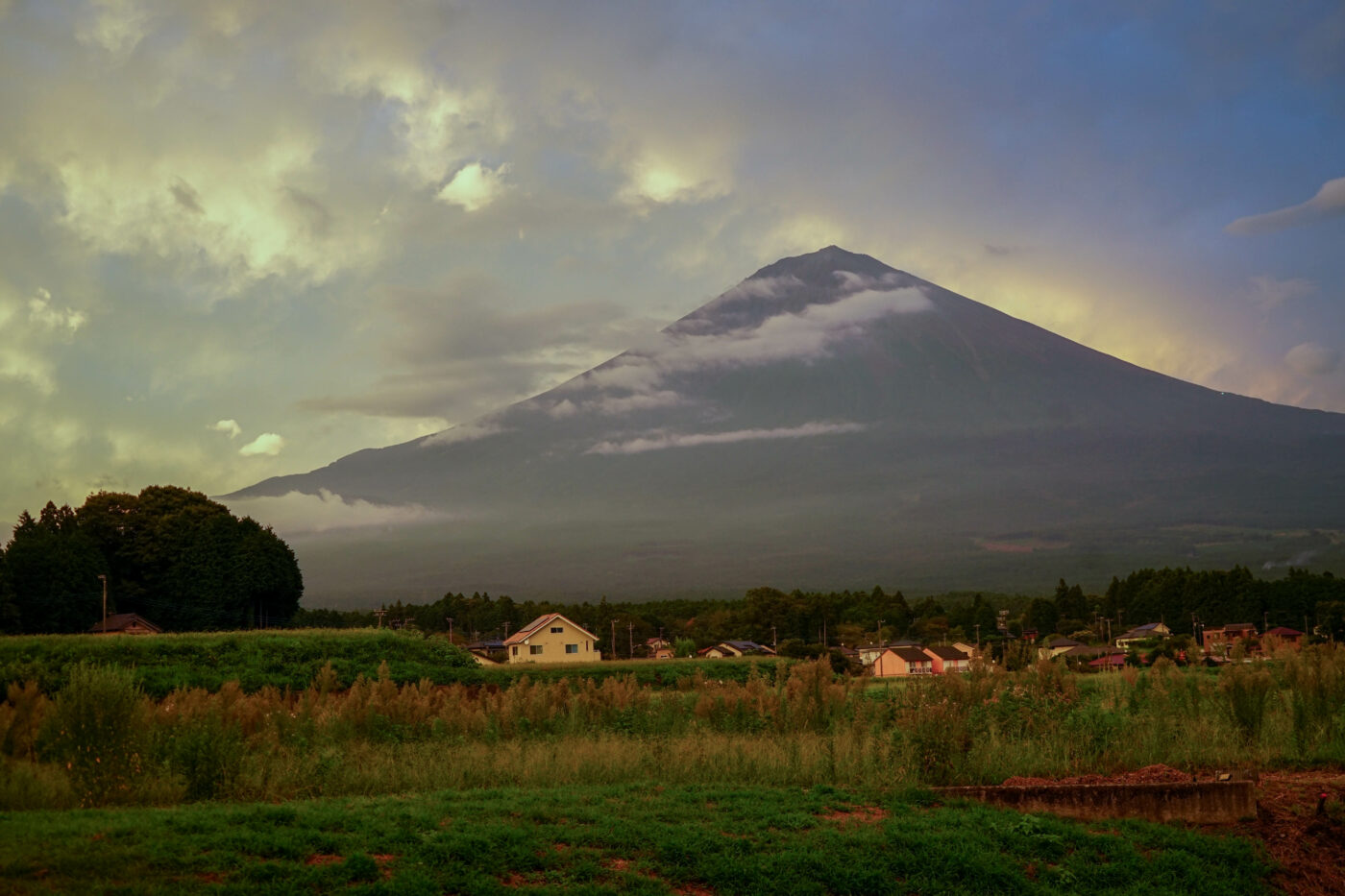
That evening, after a fantastic BBQ dinner outdoors, we gathered to revise our plans for hiking Mount Fuji the next day. We were meant to hike during the day and stay at the mountain huts overnight, but the high winds meant the trails were closed.
Day 5: Adapting Plans Around Mount Fuji
The anticipation of hiking Mount Fuji had been a highlight of our itinerary, but as adventure travelers know, adaptability is key.
With the trails closed due to inclement weather, our plans took an unexpected turn. However, Shannon, our host from Kodo Travel, was quick to adapt, ensuring our extra day around Fujisan was just as enriching and memorable.
That day, we headed into town to explore the temples that offer breathtaking views of Mount Fuji. The sight of the majestic Mount Fuji from these sacred grounds was brilliant, offering a different perspective of the mountain’s magnificence.
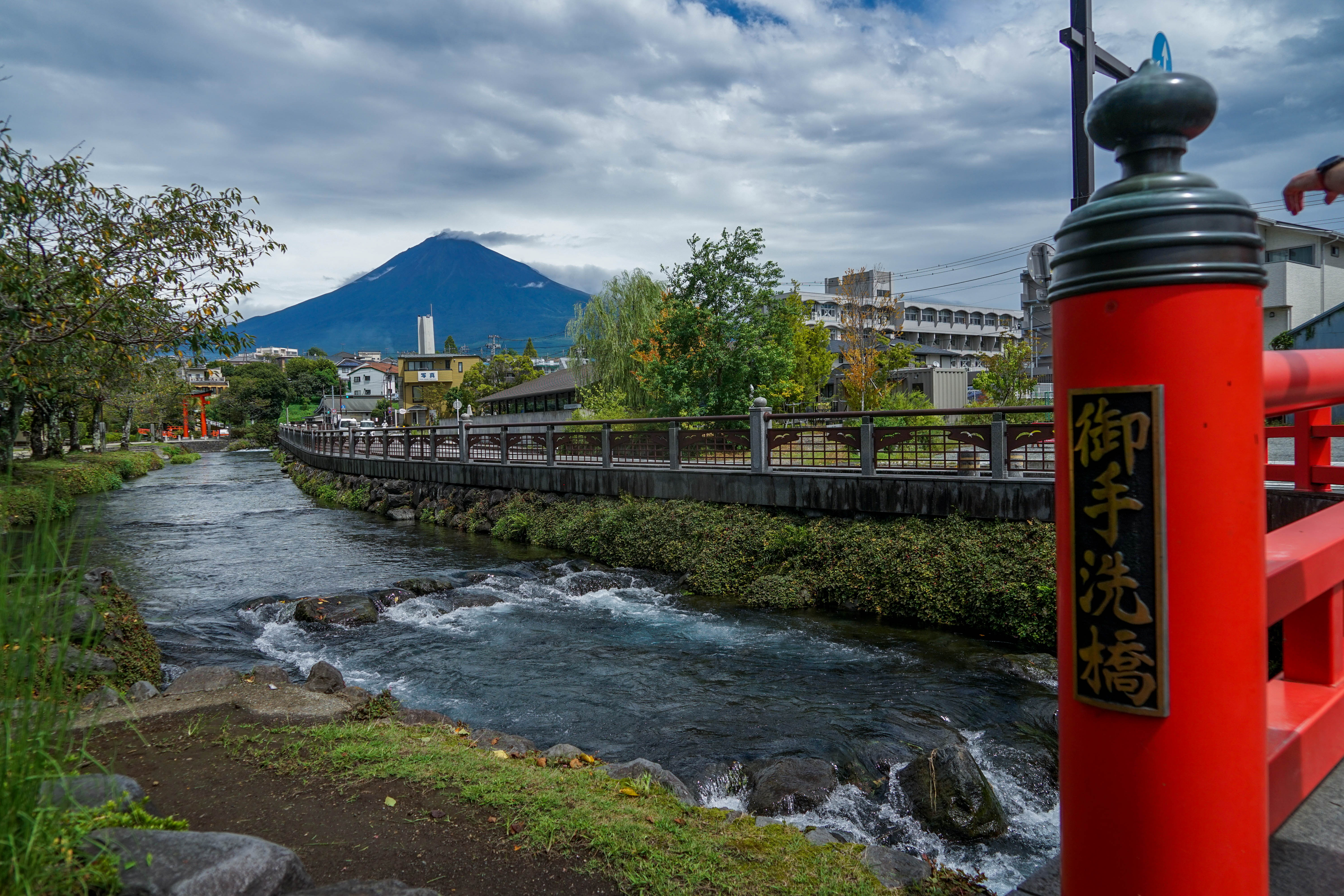
Our revised Shizuoka itinerary also included a visit to the Mount Fuji World Heritage Site, which has a beautiful architectural design inspired by the mountain itself.
The visit was an educational experience, allowing us to delve deeper into the significance and history of this iconic mountain.
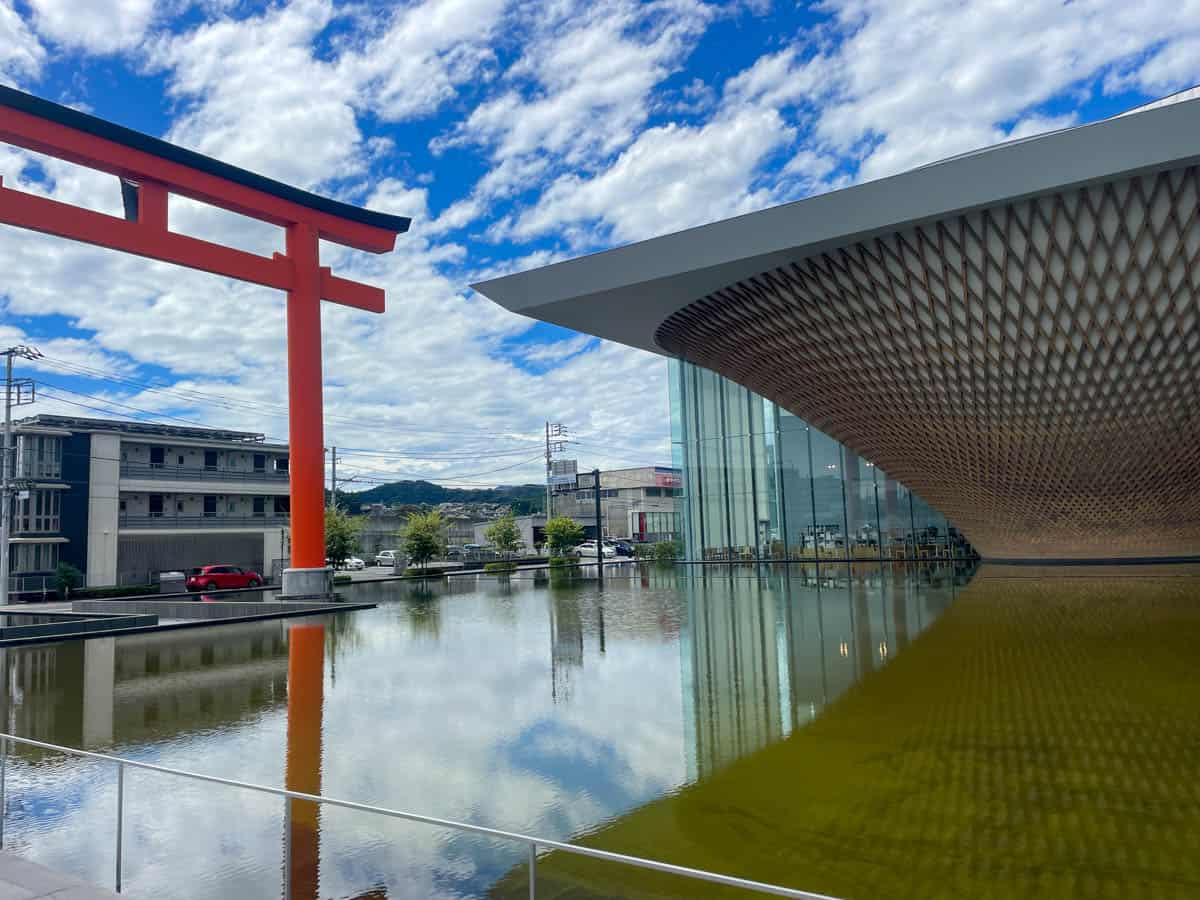
From there, we went to visit a local sake maker, ready to dive into the world of Japan’s most famous beverage.
We were not only able to taste various types of sake but also got a firsthand look at the fields where the rice used in the brewing process grows. It was fascinating to see how the simple ingredient of rice transforms into a complex and nuanced drink that’s celebrated worldwide.
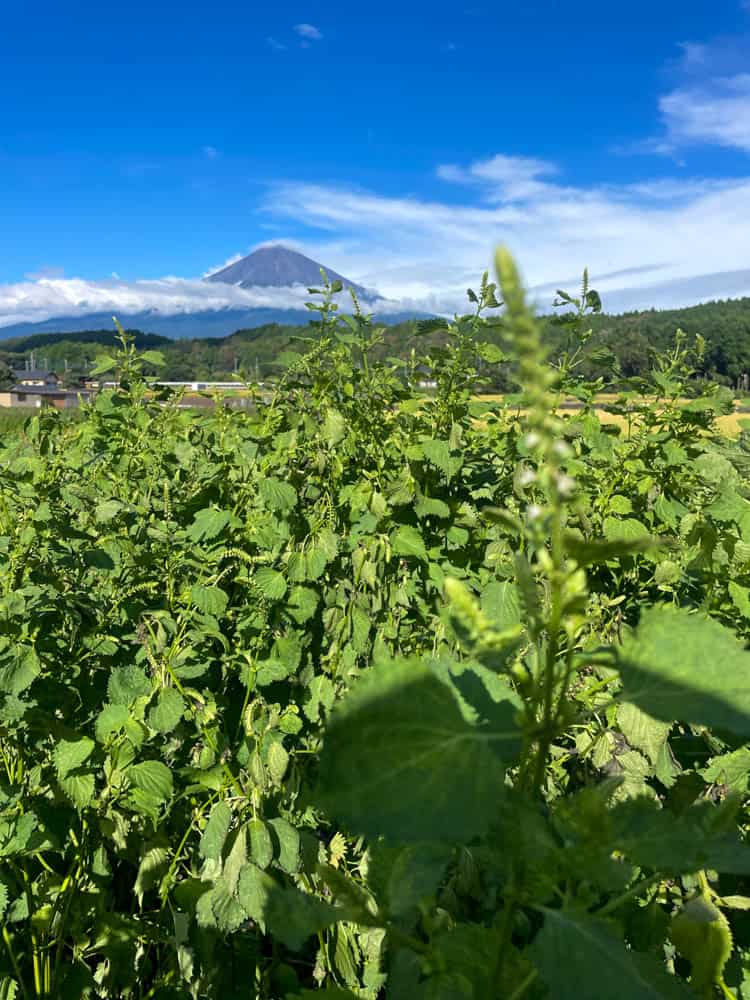
After picking up some last-minute supplies for the hike, we headed back to Masa’s Lodge for an incredible family-style dinner. They had invited the locals from the village to cook and have dinner with us, and we gave them the fresh wasabi as a gift.
This wasn’t just a meal; it was a cultural exchange, a sharing of stories, laughter, and traditions.
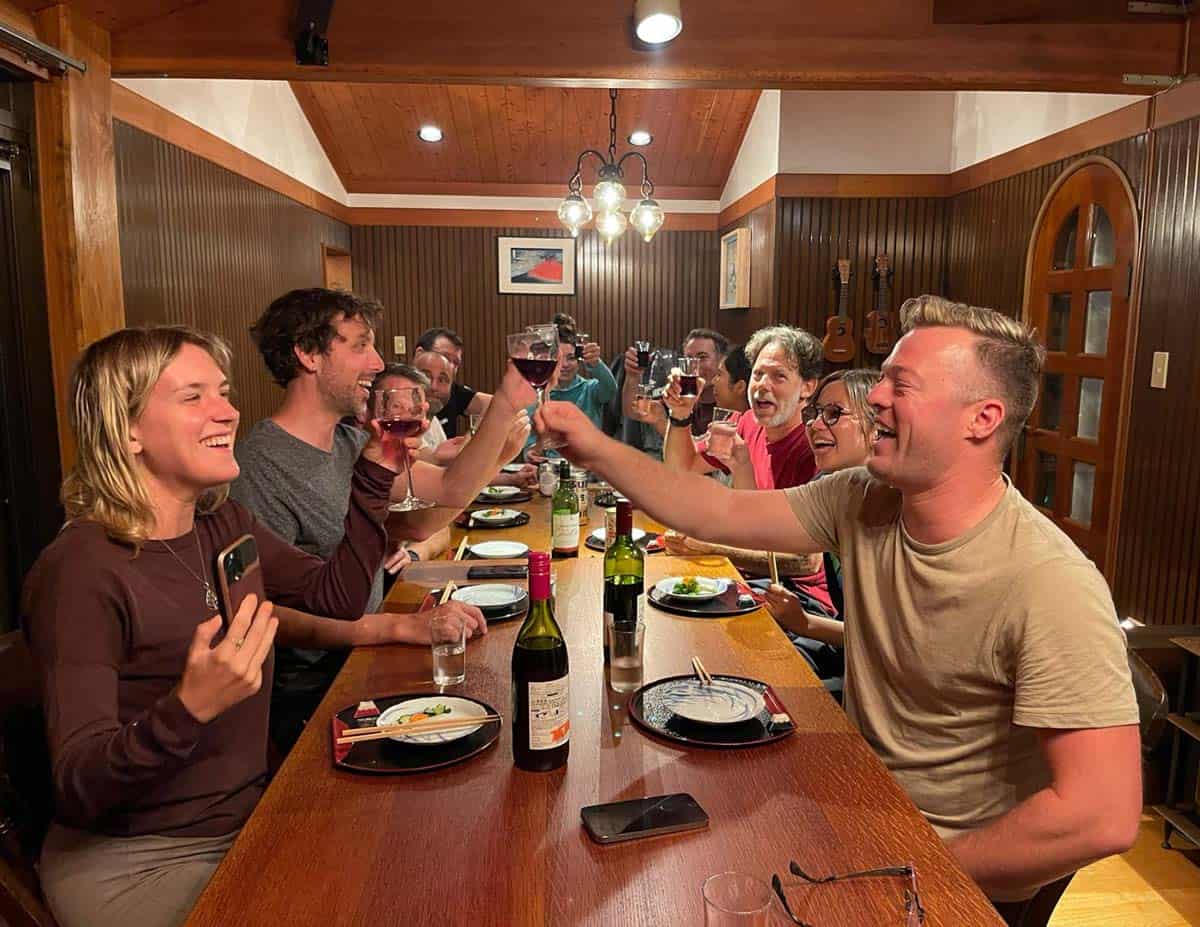
The day turned out to be a wonderful exploration of the area surrounding Mount Fuji. While we couldn’t hike the mountain that day, the alternative activities offered us unique insights and experiences.
It was a reminder that travel is about embracing the unexpected, finding joy in the new plans, and making the most of every situation.
Day 6: Hiking Mount Fuji
Our collective eagerness to hike Mount Fuji was undiminished, despite the weather-induced changes to our original plan. With the climbing season coming to a close, it was our last opportunity to ascend the iconic mountain.
Shannon presented us with a bold alternative: tackling the hike in a single day, without an overnight stay or a guide.
As a group of adventure travelers, the prospect of this intense, one-day hike was met with enthusiastic agreement. Understanding the magnitude of this endeavor, we set out early the next morning.
Masa, ever the supportive host, dropped us off at the bus station for our journey. Our Mount Fuji adventure began under a rainy sky, setting a dramatic tone for the day.
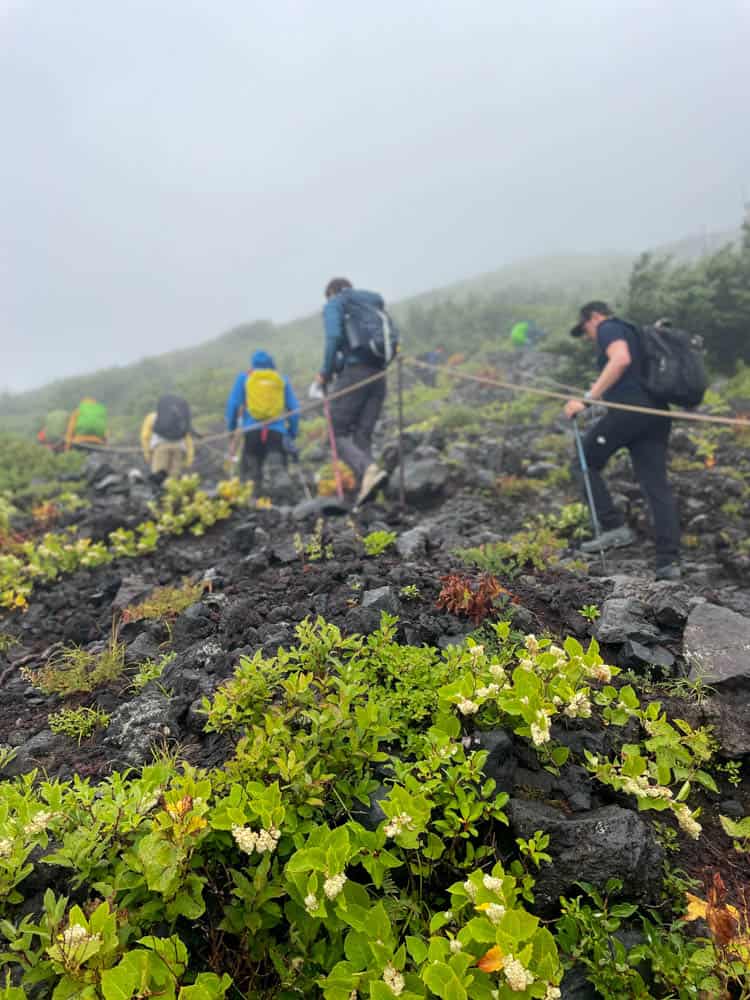
Starting from the Fujinomiya 5th station, we embarked on a guided ascent through a primeval forest along the Fujinomia route. The trail is essentially one giant stairmaster with constant switchbacks, but we kept ourselves motivated, stopping at mountain huts to catch our breath along the way.
As we climbed higher above the cloud line, it felt completely surreal.
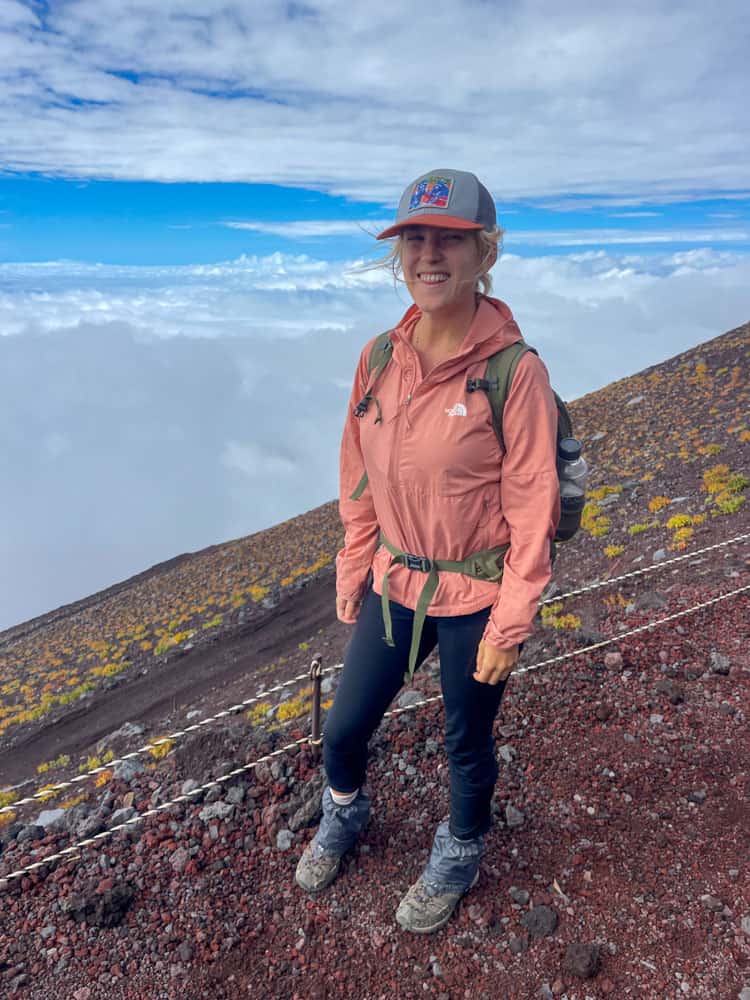
It took us about four hours to reach the summit of Mount Fuji. The sense of accomplishment was palpable at the top, especially considering we had completed the ascent in a single day. We even had time to walk along the ridge of the volcanic crater.
At 3,776 meters, Fuji isn’t just a walk in the park. You feel every meter of that elevation. Usually, to dodge altitude sickness, you’d take it slower or sleep in a hut overnight to let your body adjust. But we powered through in one day.
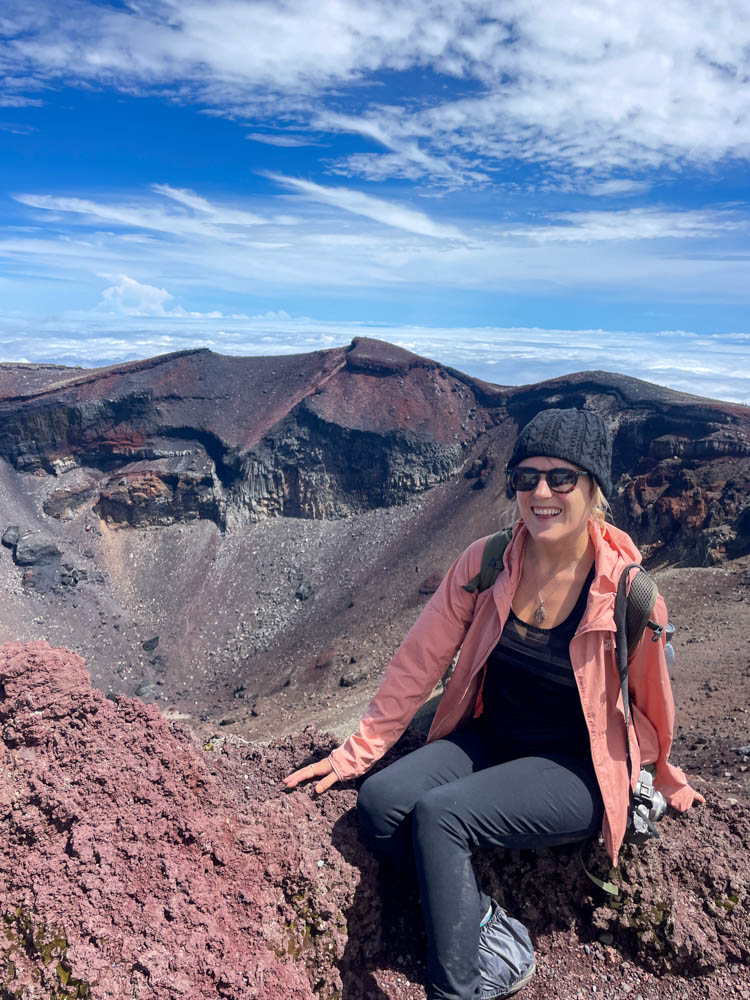
As we got to the top, the altitude did begin to hit me and cause a headache. But as soon as we started our descent, the headache began to fade.
Reaching the summit was unreal. Sure, the headache was a nuisance, but the views? Absolutely worth it. We cracked open some summit sodas (okay, beers), snapped a ton of photos, and high-fived like we’d just won the lottery.
Walking around the crater, you’re literally on top of Japan, looking down. It’s a moment I’ll never forget.
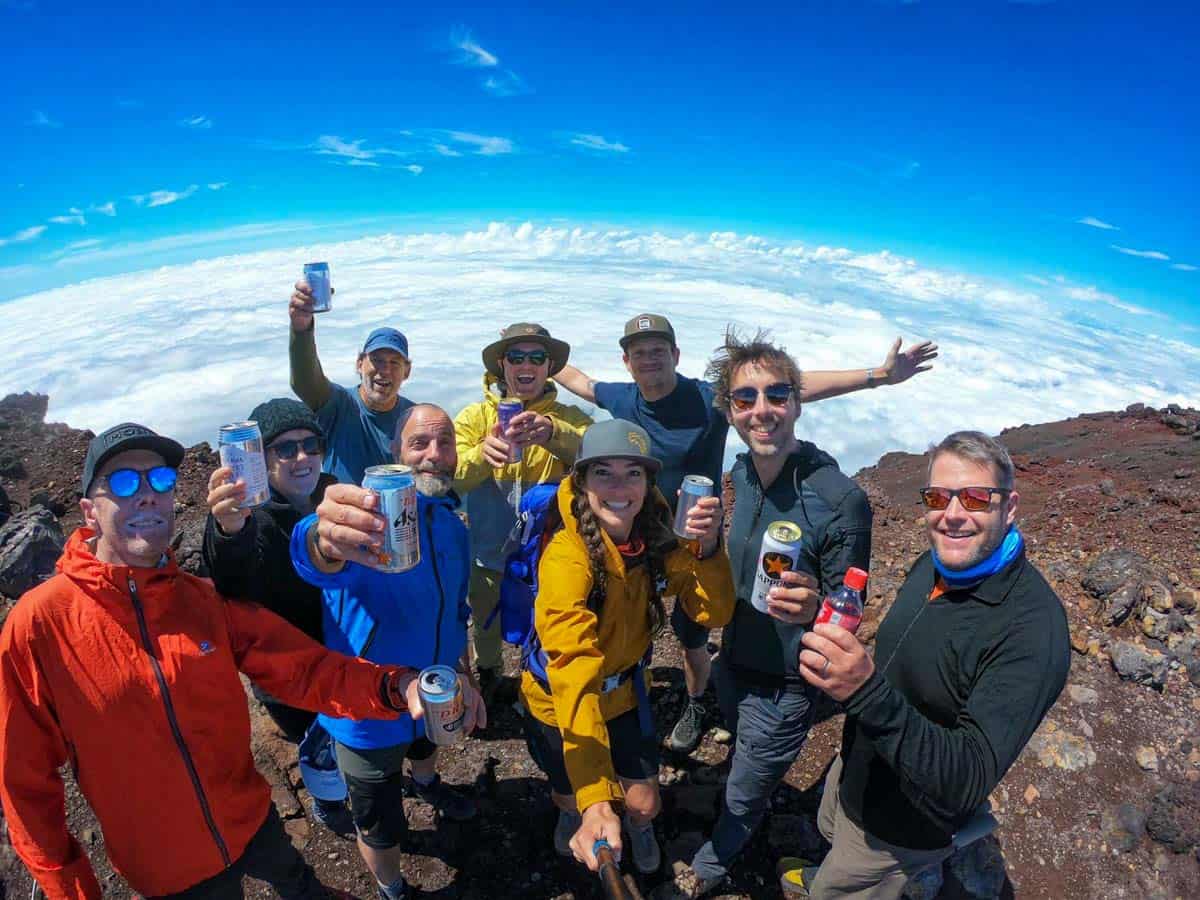
Heading back down, we noticed the crowds a lot more than going up, as it was the last night of the hiking season to use the huts. But even with the human traffic jams, coming down was more manageable compared to going up. Maybe it was the excitement of having made it, or perhaps just being closer to oxygen-rich lower altitudes.
After the exhilarating yet exhausting feat of hiking Mount Fuji in a single day, we returned to the welcoming haven of Masa’s place, ready for some much-needed relaxation and recovery.
One of the first things we did upon our return was to indulge in the unique experience of the tent sauna.
We then gathered around a cozy fire, basking in the warmth and camaraderie. It was the perfect way to end a day of adventure – swapping stories, laughing, and just being in the moment.
Day 7: Departure
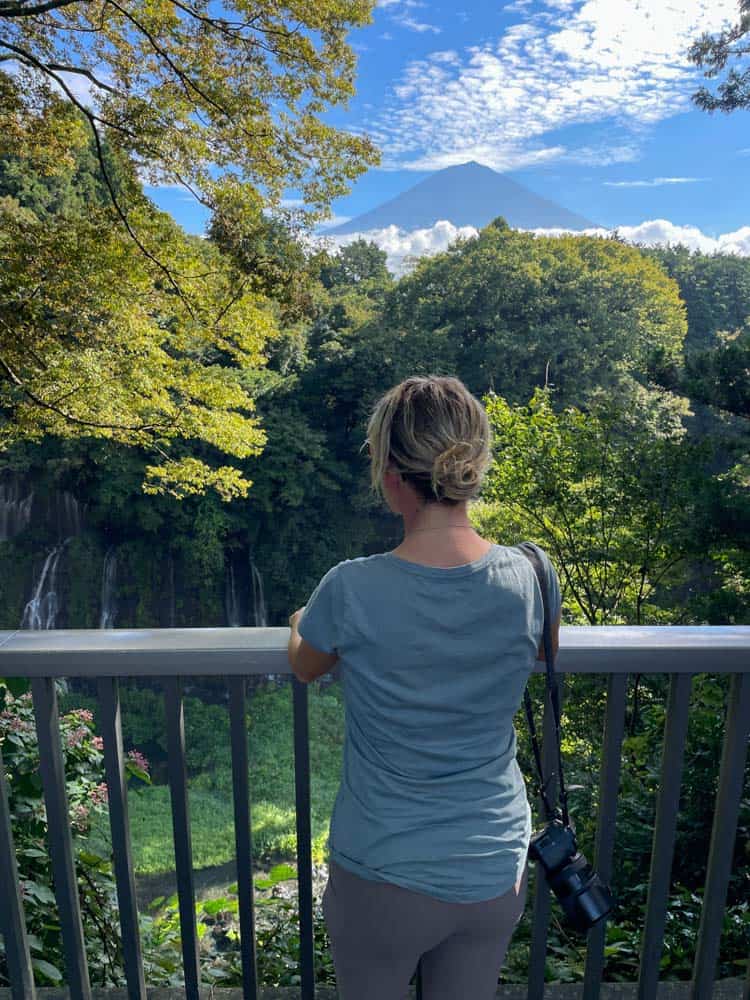
On our final day, we embarked on one last adventure. Masa took us to a nearby waterfall, a hidden gem that offered a spectacular view with Mount Fuji majestically towering above it.
The sight of the water cascading down with the iconic Mount Fuji in the backdrop was breathtaking. It was a moment of quiet reflection and appreciation for the natural beauty we had been immersed in throughout our trip.
Standing there, surrounded by the tranquility of nature, we all shared a sense of awe, a fitting conclusion to our adventure-filled journey.

After soaking in the beauty of the waterfall, it was time to say goodbye. Masa and his wife accompanied us to the train station, a gesture that spoke volumes of their warmth and hospitality. As they waved us off, our hearts were filled with gratitude and fond memories.
Masa and his wife aren’t just hosts; they embody the essence of Japanese hospitality. Their kindness and attention to detail made us feel more like family than guests.
From sharing meals with the locals to ensuring every aspect of our stay was comfortable and memorable, they went above and beyond to give us a memorable trip.
About Kodo Travel
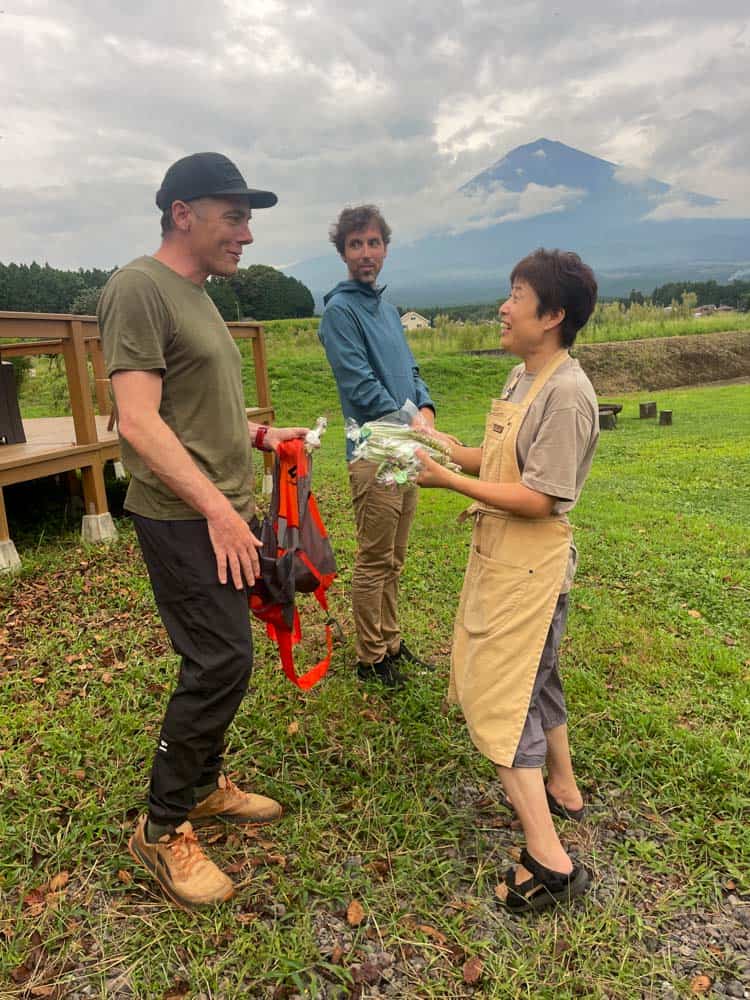
The itinerary, crafted by Kodo Travel, was nothing short of a deep dive into the heart of Japan’s natural beauty and cultural richness.
Their philosophy is rooted in the concept of connecting with the land and its people through active movement, and their commitment to sustainable and immersive experiences aligns perfectly with the ethos of responsible travel that I advocate for.
If you’re looking for help planning an incredible trip in Japan that immerses you in culture and helps the communities you visit, reach out to Kodo Travel to help you.
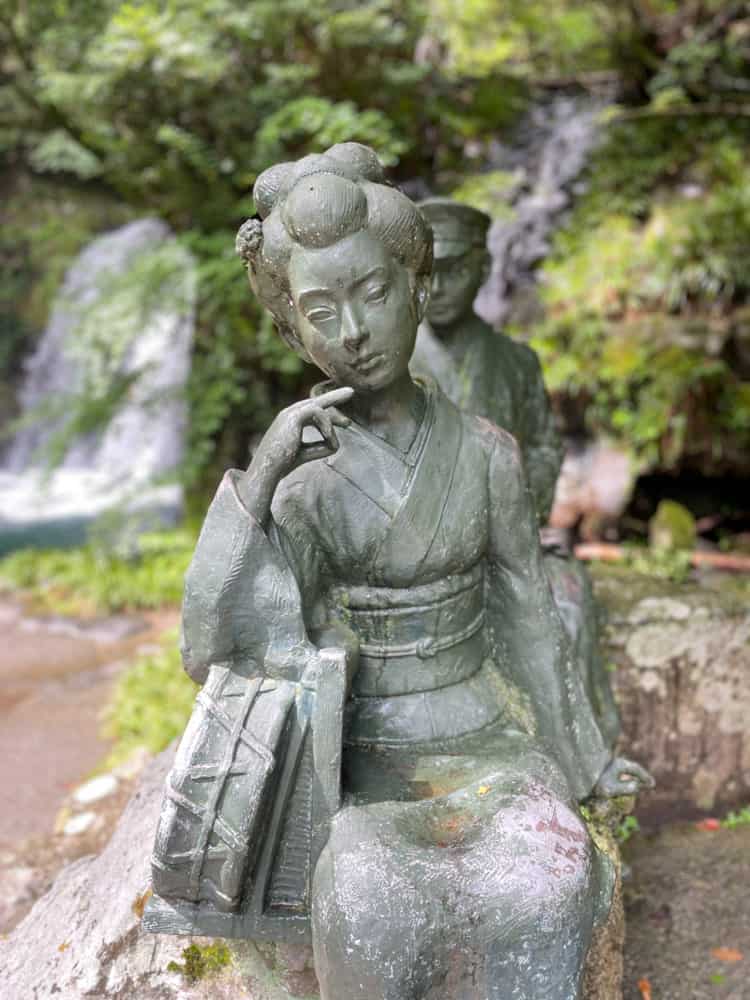
FAQ: Shizuoka Itinerary
How many days should I spend in Shizuoka prefecture?
Aim for at least 3-4 days in Shizuoka to fully enjoy its natural beauty, cultural sites, and culinary delights.
Is it worth going to Shizuoka?
Absolutely, Shizuoka is a must-visit for its breathtaking views of Mt. Fuji, adventure activities, and scenic coastlines.
What is Shizuoka Japan known for?
Shizuoka is famous for its premium green tea, stunning views of Mt. Fuji, and the beautiful Izu Peninsula.
Can you see Mt Fuji from Shizuoka City?
Yes, on clear days, you can enjoy spectacular views of Mt. Fuji from various points in Shizuoka City.
How do you get around Shizuoka Japan?
Shizuoka can be explored via trains, buses, bikes, and rental cars, with efficient public transport options available.
What food is Shizuoka Prefecture famous for?
Shizuoka is renowned for its fresh seafood, wasabi, and green tea.
What does Shizuoka mean in Japanese?
Shizuoka translates to “Quiet Hills” in Japanese, reflecting its serene landscapes.

Final thoughts: Shizuoka Itinerary
Shizuoka itinerary offers so much more than just the iconic silhouette of Mount Fuji.
The journey from Tokyo is a swift transition from urban hustle to nature’s calm, making Shizuoka an accessible escape that feels worlds apart. Getting around is a breeze, with each mode of transport offering its own scenic views, from the winding roads through coastal villages to the efficient bullet train slicing through the countryside.
But it’s not just the sights and sounds that make Shizuoka special; it’s the taste. Dining here is a journey through Japan’s culinary landscape, with Shizuoka’s wasabi and green tea standing out as local treasures that add a unique flavor to the experience.
From the awe-inspiring views of Mount Fuji to the serene beauty of the waterfalls and the warmth of the local hospitality, Shizuoka is a reminder of the diverse experiences Japan has to offer.
